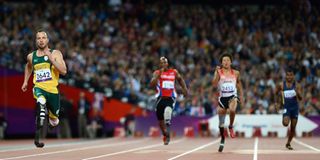Debate on prosthetics and shoe technology won’t go away soon

South Africa's Oscar Pistorius (left) competes in the men's 200m T44 round 1 athletics event during the London 2012 Paralympic Games at the Olympic Stadium in east London, on September 1, 2012.
What you need to know:
- Cas ruled that the blades allowed the American to run at a height several inches taller than if he ran with biological legs, thereby giving him “significant competitive edge.”
- On February 19, World Athletics had deemed Leeper ineligible to compete in international events, including 2020 Tokyo Olympics in 2021, against able-bodied athletes, promoting his lawyers to file an appeal at Cas
- Leeper’s lawyers said that the height limitations, known as Maximum Allowable Standing Height (Mash) that Paralympic organisations use, are based solely on “body proportions of white and Asian athletes.”
Early this week, the Court of Arbitration for Sport (Cas) turned down an appeal by American double amputee, Blake Leeper, who wanted World Athletics to allow him to use his prosthetic running blades to try to qualify for 2020 Tokyo Olympic Games.
Cas ruled that the blades allowed the American to run at a height several inches taller than if he ran with biological legs, thereby giving him “significant competitive edge.”
On February 19, World Athletics had deemed Leeper ineligible to compete in international events, including 2020 Tokyo Olympics in 2021, against able-bodied athletes, promoting his lawyers to file an appeal at Cas.
At the time, World Athletics had argued that Leeper’s mechanical aids (prosthetics) would give him unfair competitive edge over able-bodied competitors. Indeed, World Athletics rules permit competitive use of aids such as prosthetics if they do not give the user an artificial competitive advantage.
The rules date from March 26, 2007 when World Athletics (WA) (then known as IAAF) amended its competition rules to include a ban on the use of "any technical device that incorporates springs, wheels or any other element that provides a user with an advantage over another athlete not using such a device".
In February, Leeper’s legal team rejected the position. On Monday, the American’s lawyers dismissed the Cas verdict, saying that the finding that he “runs tall” is based on a “racist Paralympic rule" and vowed to challenge the decision at the courts. Naturally, WA rejected the lawyers’ remarks.
Leeper’s lawyers said that the height limitations, known as Maximum Allowable Standing Height (Mash) that Paralympic organisations use, are based solely on “body proportions of white and Asian athletes.”
Behind bars
I am not a lawyer and I will not go into the merits and demerits of the case, but Leeper’s case mirrors that of Oscar Pistorius, the South African “Blade Runner” who successfully appealed to Cas when faced with a similar situation and was allowed to compete against able-bodied athletes in the Olympics with the aid of prosthetics.
Pistorius, who is behind bars now after being convicted of murdering his girlfriend Reeva Steenkamp in 2013, won many races as an athlete. Most notably, he competed in T44 (category for single below-knee amputees) in 100 metres race at the 2004 Olympics in Athens and finished third. He also won 200m race at the same championship in a world record time.
In 2007, a series of scientific tests which Pistorius attended at the German Sports University Cologne revealed that “the runner’s limbs used 25 percent less energy than those of runners with complete natural legs running at the same speed, and that they led to less vertical motion combined with 30 percent less mechanical work for lifting the body.”
In 2008, IAAF (now WA) ruled that Pistorius's prostheses were ineligible for use in competitions conducted under the IAAF rules. The athlete successfully appealed to CAS. He would win gold medal in 100m, 200m and 400m (T44) at 2008 Olympics.
First amputee Olympian
He represented South Africa in 400m and 4x400m relay against able-bodied athletes at the 2011 World Athletics Championships in Daegu, South Korea. As part of South Africa’s 4x400m relay team that took silver medal at the championship, Pistorius became the become the first amputee to win a non-disabled world track medal.
More was still to come. At the 2012 Olympic Games in London, he became the debut amputee runner to compete at the quadrennial Games as part of South Africa’s 400m and 4x400m relay teams.
In 2012 Paralympic Games, Pistorius won gold in the T44 400m with a time of 46.68 seconds, breaking the Paralympic record. Although he became the archetypal tragic hero a year later in a script he himself wrote when he was convicted of murdering his girlfriend Steenkamp, Pistorius’ experience offers Leeper some hope.
Just like the debate on shoe technology, the talk on use of prosthetics in races featuring able-bodied athletes will not go away soon.





